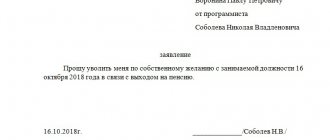Making entries in the work book
As a general rule, the general director is considered the sole executive body of the organization. He makes management decisions personally without obtaining a power of attorney from the founders. Accordingly, it is he who acts as the employer and is responsible for storing work books, as well as making entries in them in accordance with the law.
While the organization is operating, the general director has the right to issue orders on personnel matters, including in relation to himself. For example, he can provide himself with annual paid leave, since he is the immediate manager of the organization.
Also see: The Most Important Thing About CEO Salary.
If the general director is to be dismissed, the employment record must be signed by him (if there is no other person authorized by him to do so). This provision on the work of an LLC is enshrined in Article 40 of Law No. 14-FZ. The day of dismissal is officially considered the last working day, so the general director has every right to act as the head of the organization, since he is the employer. He independently certifies the entry in the work book with his signature.
An entry in the book can also be certified by the owner of the company - the sole founder or one of them. If an employment contract is concluded with the general director, it is also signed by one of the founders, acting on behalf of all the founders of the company.
How is a mark entered into the book?
According to the rules of document flow, the entry is made on the day of dismissal of the employee and is drawn up as follows:
- The first column is a serial number; the next record number in sequence is written here.
- The second column is the date, respectively the day, month and year when the required note is made.
- The third column is information about work and work activity.
In case of leaving work, an entry is made indicating the reason and a link to a specific article of legislation. This information must be entered and is probably the most basic in this entry. After all, this is the only document demonstrating the actual reason for leaving work, and the next employer will be able to analyze the employee’s work activity. Example: Dismissed due to a decision by the general meeting of owners to terminate the employment contract, in accordance with paragraphs. 2 tbsp. 278 Labor Code of the Russian Federation. - The fourth column is the details of the documents on the basis of which the entry was made. Accordingly, this is an order or other document regulating the release of an employee’s position. If the basis is the minutes of the general meeting of the board of directors, then all its details are entered here.
- After recording, it is necessary to put the signature of the manager , the seal of the organization and the signature of the dismissed person.
The dismissal record must contain the manager’s signature and seal, otherwise the record will be considered invalid.
Next, you can see a sample entry in the employment contract about the dismissal of a director by decision of the founder.
Here is a sample entry in the work book about the dismissal of a director at his own request.
In this photo you can see what the employment record looks like about the dismissal of a director due to the liquidation of the LLC.
Who makes the entry and who signs?
The mark is made by the person who is responsible for the registration, maintenance and accounting of work books. Most likely, this is the personnel department, but it happens that this person turns out to be the director himself, which is why he makes the recording. Thus, it turns out that there are two signatures of the same person in a row , but you should not neglect the rules for drawing up such documents.
date of dismissal
The important point is the date. The entry in the book must be made directly on the last day of work and coincide with the date specified in the order. The importance of this point is related to the employee’s remuneration; if a mistake is made, even for one day, the person has the right to wages for the hours worked.
As a general rule, a resigning person is required to work for two weeks , but for an official this period has been increased to one month. This is done with the expectation that the manager will have enough time to transfer all his affairs, and the board of directors can choose a new boss.
General design rules
The question often arises of how to fire a CEO. Labor difficulties arise with recording, since the law does not make exceptions for heads of organizations. All personnel records in their regard are prepared as for ordinary employees.
When dismissal, the reason for dismissal must be reflected in the work book. We list the most common formulations:
- at your own request;
- in connection with the adoption of a decision by the meeting of shareholders;
- in connection with the termination of the organization’s activities;
- on the basis provided for in paragraph 3 of Art. 278 of the Labor Code (usually this provision is used if the general director is fired due to improper performance of duties).
In particular, in Art. 278 states that an employment contract can be terminated due to the grounds established by it. That is, if the founders entered into an agreement with the manager, and he failed to fulfill the duties assigned to him, the work book must indicate dismissal under this article of the Labor Code.
Also see “Entry in the work book about dismissal during liquidation of the enterprise.”
Dismissal of a manager
First, the founders of the legal entity make an appropriate decision (it is not required when dismissing at will or upon expiration of the contract with the manager). The grounds for dismissal of a director can be the same as for ordinary employees (Article of the Labor Code of the Russian Federation), or special, such as dismissal due to disqualification (clause 8 of Article 83 of the Labor Code of the Russian Federation) or by decision of the founders to terminate the employment contract with the director ( Subclause 2 of Article 278 of the Labor Code of the Russian Federation).
The official warns senior management in writing about his upcoming resignation at his own request no later than a month in advance. If a fixed-term contract has been concluded, the director must be notified in writing 3 calendar days before its completion.
A dismissal order is issued in Form No. T-8. The General Director must familiarize himself with it and sign for familiarization.
An entry about the dismissal of the general director is made in the work book. The entry must comply with the text of the order (and the wording of the Labor Code of the Russian Federation).
On the last working day, the manager is given a work book against signature, and a full payment is made.
All personnel records for officials are prepared in the same manner as for ordinary employees. The founders of the LLC must notify the tax office of the change of general director (within 3 working days from the day the new general director began performing his official duties).
Features of dismissal of the CEO
Correctly recording the dismissal of the general director is not the only task of the founders of the LLC, who will have to change the director. Society must also:
- hold a meeting and prepare a decision on changing the manager;
- data on the change of the executive body of the company must be transferred to the tax office within the established time frame.
Also see “We notify the Federal Tax Service about the change of the general director.”
On the day of dismissal, a full settlement must be made with the former head of the enterprise. He receives the benefits he is entitled to.
Read also
31.08.2018
Procedure for making an entry
The General Director , like any other employee, regardless of the level of the position held, has the legislative right to enter relevant data about his work history.
A feature of maintaining this document by an employee holding an official position in the organization and having the duty to make all management decisions is the ability to enter the necessary information:
- by himself;
- HR representative;
- owners of the organization or chairman of the joint-stock company;
- any other official who is authorized to perform the relevant actions.
Like any other employee, a top-level manager has the right to leave his position:
- at his own request, by submitting a corresponding application at least two weeks before leaving his position;
- “farewell” to the production of the general director may be caused by the bankruptcy of the organization;
- the decision to dismiss him can be made by the board of directors, the founder of the production, the supervisory board and other similar structures.
In the latter case, the employee is sent a written notice informing about the fact of termination of the labor relationship, indicating the reasons.
Sample entry on the dismissal of the general director in the work book:
Features of the legal status of the general director of an LLC
The key difference between the general director of a company and any other employee, including top managers, is that he, even if he is not a member of the founders, is the executive body of the company with the right to make sole decisions. And in the event of his sudden self-removal, the company’s activities will be paralyzed.
In addition, the General Director in personnel matters is vested with the right of sole decision regarding all personnel except himself. He himself is hired by the founders and they exclusively have the right to fire him, including at their own request.
This rule applies even in a situation where the general director is two persons and at the same time is also the sole founder. In this situation, although he fires himself, he, as the person firing, acts as a founder, and in the role of the general director, only as the person being fired. If he is one of the co-founders, then the issue of his dismissal must be agreed upon with other participants in the company.
Hires the general director and dismisses the general meeting of founders or the sole founder of the LLC
In the legal field, these features of the position of the general director are reflected at the legislative level. The Labor Code of the Russian Federation provides for the obligation for those with this status to notify the employer of their desire to leave him, that is, to write a letter of resignation, a month in advance, and not two weeks in advance, as for the rest of the staff. The Law “On LLC” also contains additional requirements. According to it, in addition to the application, the first person of the company is obliged at the same time - one month before the desired date of dismissal - to inform each member of the company individually about his decision, for which a separate document form is provided.
Therefore, if it is enough for an ordinary employee to submit a resignation letter of his own free will two weeks in advance, then two documents are required from the first person of the company, which are submitted a month before the expected departure:
- Application for resignation of one's own free will.
- Notice of voluntary resignation.
And these documents are sent to all the founders, while other employees, up to the deputy general director, only need to write an application once and run it through the chain of command in accordance with the company’s document flow.
The difference between the dismissal of a general manager and just a director
To begin with, it is worth identifying the nuances of terminology. The position of the first person of the company can be called differently - general director, simply director, president, etc. But the determining factor is the real powers assigned to the person occupying this position by the company's charter. After all, a position can be called whatever beautiful name you like, but if the authority is at the level of a deputy chief executive or a mid-level manager, everything is determined by them.
In many companies, even small ones, the word director is included in the title of almost all top positions. But in all cases, except for those where the company’s charter provides for collegial management, in fact only one of them acts as the general director, and the rest, at most, act as his deputies.
For some time, the author of these lines worked in a company where there was a whole board of directors: commercial director, development director, product sales director. At the same time, the company's staff did not exceed 20 people. However, in reality, the commercial director, for example, acted as head of the advertising department, and the sales director acted as head of the logistics department. And only the general director had directorial powers across the entire spectrum.
Thus, if there is more than one director in a company, the special procedure for voluntary dismissal is relevant only for one of them who is the first person of the company with the right to make sole decisions. And the rest are dismissed according to the same procedure as regular personnel, which in fact they are.
Step-by-step instruction
When hiring a manager for a position by the personnel service of municipal self-education, he is required to provide documents confirming his qualifications and necessary for employment:
- Education document.
- Employment history.
- Application for a job.
The application is written to the head of the department (division). After its approval, an order of appointment is prepared and the wording of the entry is entered.
If the position is elective in a municipal institution, LLC, CJSC, etc., a decision of the constituent meeting is necessary. Based on it, an order is created, and based on the order, a record is made. It is most advisable, according to experts, to indicate in the fourth column the document on the basis of which the appointment order and the order itself were issued, in a form typical for all information.
When filling out the work record, you must first enter in the third column, where information about the work is reflected, the name of the organization that makes an entry in the work book of the general director about hiring or enter your organization, unless otherwise provided. In this case it is not allowed:
- put a serial number;
- indicate the date.
Next, enter sequentially:
- In the first column is the serial number of the entry, based on the number under which the previous entry was made.
- In the second column is the date of hiring of the director. Do not confuse this with the date the information was entered or the date the order was issued.
- In the third column is the entry itself, which reflects information about the boss’s hiring: whether he was accepted, elected, appointed, etc. to his position.
- Two documents as legal grounds: an order and a decision or one of them.
Summary
- The books must be kept by the head of the company.
- Powers can be delegated to a secretary or personnel officer. To do this you need to issue an order.
- There is no need to write extra words next to the employee’s signature on the work report. A specialist's painting is enough.
- If the job title is long, you can replace it with the word employee.
- The rules must be strictly followed, otherwise you will have to pay fines.
- The specialist signs after the personnel officer. You cannot skip columns.
- The employee must sign his autograph not only in the work book, but also in other documents. The signature certifies the personal card, the labor book and the order.
Stamp in the work book upon dismissal and basic requirements
The last element of certification of the dismissal record, as noted earlier, is the seal. The first aspect of this point that is worth dwelling on is what kind of seal should such a record be certified with? Previously, you could choose from two options:
- seal of the operating organization (enterprise);
- seal of the HR department (service).
But since 2008, the Rules have been somewhat transformed . A number of amendments made included an order from Rostrud to replace part of the phrase in paragraph 35 “... with the seal of the organization (personnel service) …” with “... with the seal of the employer.”
The changes were caused by the need to bring the Rules into maximum compliance with the current Labor Code, which uses a single term “employer”.
In other words, after these amendments come into force, certification of a dismissal record using the seal of the HR department is considered a gross violation of the procedure. Regarding the location of its imprint, there are a number of corresponding requirements:
- the seal cannot cover personal signatures or make it difficult to read other important details (for example, order number);
- the imprint should slightly overlap the job title of the person being dismissed, ideally occupying most of the empty lines at the bottom;
- The printing on the document must be clear and readable.
How to properly certify a record
The rules stipulate that the employee signs after the entry is made.
Traditional design scheme:
- The HR specialist indicates his position.
- signs.
- does the decoding. For example, he writes: Ivanov A.L.
There is one important point here.
The rules prohibit abbreviations on the form. It turns out that putting initials instead of the full name and patronymic is incorrect. Therefore, there is a second assurance option. Sample: Ivanov Alexey Leonidovich. Another question arises: to indicate the position of a specialist or not. When the official receives the document on the last working day, the position is indicated. If a person has already quit and takes the form, then the position is not written.
Writing the words “I assure” and “I have become familiar” also makes no sense. The law does not establish an obligation to write additional words for those who sign the work book upon dismissal.
Important! The specialist must sign not only the book, but also the personal card. Personal cards must be kept in paper form; registration using a computer is not allowed.
So, there are several options for how to fill out the documents. You just need to choose the appropriate option and follow the requirements of the Rules and Instructions for filling out the books.
Hiring by translation
In the case when hiring is carried out by translation, the following documents must be additionally attached to the listed documents:
- statement;
- order.
These documents are provided as confirmation of the permission of the translation by the organizations. That is, the director gets a job before leaving his previous one. When submitting an application for employment , he waits for it to be confirmed by a superior in the hierarchy and the order is issued.
With the received order, he turns to the previous employer. Based on this order, he is dismissed in the order of transfer, and in the desired place he is accepted in the same way - in the order of transfer. However, if the admission is subject to a decision being made by the meeting or in the case of an elective position, this process cannot be canceled.
It must be carried out under the conditions of the director’s transfer at a convenient time for this, but no later than the execution of the employment order.
After making a record of dismissal by transfer, you do not have the right to accept the provided labor for production if the transfer indicated in the document concerned not yours, but some other organization.
Only a transfer made on the basis of your document (order, agreement, approved application) that you provided for the dismissal of the director to his previous place of work has legal force.
If a transfer to the position of director is carried out within one organization as a result of a promotion, the entry is made in the usual way, without reference in the wording about the transfer to another position.
For example, “elected (appointed) director”, indicating:
- serial number of the record;
- dates;
- appointment order.
In this case, it is also possible to indicate in the last column two documents (if there is a second one) with which the appointment was made. The same algorithm applies when making an entry in the work book when applying for a job with a probationary period. In hiring - a sample based on the order: 0
Signature Requirements
According to the Unified System of Organizational and Administrative Documents of 2003, the word “signature” means:
- the name of the position of the person who made a note about the dismissal of the person;
- personal signature of this person (manager, secretary, personnel officer);
- FULL NAME. - decryption of the signature, the presence of which is mandatory.
The signature must be made with the same pen that was used to make the mark. It must be legible and understandable. It is unacceptable for responsibilities to be assigned to one person while another person actually does the work.
So, if the enterprise has established that the mark is made by the manager, this responsibility cannot be conditionally assigned to the personnel officer or secretary.
The chief accountant also has the right to sign the work book if he is assigned such a duty.
Where to report the dismissal of a director?
Where should I report the dismissal of the LLC director? The tax office is the only place to which you need to report the dismissal of the director of the enterprise. The way to inform is to submit an application for a change of manager.
This must be done within 3 working days from the date of dismissal . (Federal Law No. 129-FZ dated August 8, 2001). All other messages about the occurrence of this event are at the discretion of the management and founders of the organization and as necessary :
- inform the bank if the former director had signing authority;
- report to the press if there is a possibility that the dismissed person will illegally use his lost powers (sign a document illegally on behalf of the organization, etc.). The announcement must contain a message stating that the person’s signature is invalid as of the specified date.
On what grounds is a director fired?
The grounds for dismissal of a director are as follows:
- at the initiative of the employer: the reasons are listed in Art. 81 of the Labor Code of the Russian Federation, including the adoption of an unfounded decision that resulted in damage to the organization, a one-time gross violation of established labor duties;
- when there is a change of owner on the basis of Art. 81 of the Labor Code of the Russian Federation, that is, when the ownership of the organization’s property is transferred to another person;
- suspension due to bankruptcy (Article 278 of the Labor Code of the Russian Federation);
- according to paragraph 2 of Art. 278 of the Labor Code of the Russian Federation, which introduces the dismissal of a director by decision of the founder as a basis for termination of an employment contract with a director on an additional basis due to his position;
- additional grounds provided for in the employment contract (Article 81 of the Labor Code of the Russian Federation).
Like an ordinary employee, a director can resign of his own free will; in this case, the director of an LLC is dismissed at his own request; the termination of the contract is completed in accordance with a simple step-by-step algorithm.
Resolution of controversial situations
If everything goes well, the employee will have no problem signing his autograph upon dismissal. A completely different situation is when a person leaves with a scandal and refuses to certify the document. The employer needs to protect itself from blackmail and resolve the issue: whether the employee must sign the work book upon dismissal. The guidelines for action are enshrined in Article 193 of the Labor Code. The act must be signed by two, or even better, three employees, preferably not related to the job responsibilities of the dismissed specialist.
The act must be completed or you will have to pay fines. Failure to provide an autograph from a fired employee is a serious violation.
Labor law requirements must be strictly observed to avoid sanctions. The punishment is established by Article 5.27 of the Code of Administrative Offences. The violator pays fines. The manager risks receiving a fine of up to five thousand rubles. The company is subject to a penalty of thirty to fifty thousand rubles. Fines increase if repeated violations are discovered.
Certification with a seal
With this point everything is somewhat simpler, but in some situations disputes may arise. The seal should be placed at the final stage of the entire procedure. Until recently, it was allowed to use 2 printing options: institutional or personnel service. But since 2008, some adjustments have been made to the regulations of Rostrud. Thus, according to information for 2021, an entry in a work book is considered valid only if it has been certified by the seal of the institution.
That is, certification with a seal “for documents” is a gross violation of the current Legislation. A number of requirements also apply to the print:
- As mentioned earlier, a clear impression is considered correct. Smeared or not clearly printed is considered a violation.
- It is unacceptable that the seal makes it difficult to read any information; in particular, it should not completely cover the personal signatures of employees.
- The ideal option is if the seal occupies the bottom empty lines, slightly capturing the signature of the fired person.
And the main rule is that printing is a necessary attribute , so we must not forget about it. When making an entry in an employee’s work book, the responsible employee must be extremely careful. An incorrect entry or a missed step can result in serious problems for both the terminated employee and the HR person (or other employee assigned responsibilities).
When making a record, the employee must first of all be guided by the current Labor Code. And it is also necessary to study the regulatory documents to which some articles of the Labor Code refer.











